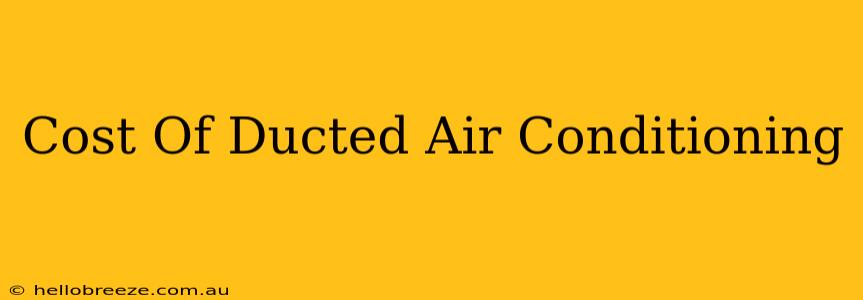Thinking about installing ducted air conditioning? It's a significant investment, offering whole-home comfort, but understanding the cost is crucial. This guide breaks down the factors influencing the price of ducted air conditioning, helping you budget effectively.
Factors Affecting Ducted Air Conditioning Costs
Several factors contribute to the overall expense of a ducted air conditioning system. Let's explore the key ones:
1. System Size and Capacity
The size of your home directly impacts the cost. Larger homes require larger, more powerful systems, leading to higher upfront costs. The capacity, measured in kilowatts (kW), determines how effectively the system cools or heats your space. A higher kW rating generally means a higher price. Proper sizing is critical for efficiency and comfort, so consult with professionals for accurate assessment.
2. Type of System
Different types of ducted systems exist, each with varying price points:
- Reverse-cycle systems: These offer both heating and cooling, often proving more cost-effective in the long run. They generally cost more upfront than single-purpose systems.
- Single-purpose systems: These are either cooling-only or heating-only. They are less expensive initially but lack the versatility of reverse-cycle systems.
Consider your climate and heating needs when choosing a system type.
3. Brand and Features
Different brands offer varying levels of quality, features, and warranties. Premium brands often come with higher price tags but may offer superior performance, energy efficiency, and longer lifespans. Features like smart home integration, zoning capabilities (controlling temperature in different areas), and advanced filtration systems all impact the overall cost.
4. Installation Complexity
The complexity of the installation significantly influences the final price. Factors include:
- Existing ductwork: If you have existing ductwork, it might be repurposed, potentially reducing costs. However, significant modifications or new ductwork installation can substantially increase expenses.
- Home accessibility: Difficult-to-reach areas or obstacles can add to labor costs.
- Location of the outdoor unit: The positioning of the outdoor unit impacts installation time and cost.
5. Labor Costs
Labor costs vary depending on your location, the installer's experience, and the complexity of the installation. Obtain multiple quotes from reputable installers to compare pricing.
6. Permits and Inspections
Necessary permits and inspections add to the overall cost. These fees vary depending on your local council regulations.
Estimating the Cost
While it's difficult to provide an exact price without a professional assessment, you can expect a wide range depending on the factors above. A basic system for a small home might start around $5,000 – $8,000, while larger homes or those requiring extensive installation might cost $15,000 – $30,000 or even more.
Remember to always obtain at least three quotes from qualified and licensed installers. Compare not just the price but also the warranties, system specifications, and the installer's reputation before making a decision.
Saving Money on Ducted Air Conditioning
Several strategies can help you manage the cost:
- Shop around for the best deals: Compare quotes from different installers.
- Consider energy-efficient systems: Higher SEER ratings (Seasonal Energy Efficiency Ratio) translate to lower energy bills over time, potentially offsetting the higher initial cost.
- Explore financing options: Some installers offer financing plans to make the investment more manageable.
Installing ducted air conditioning is a considerable investment, but the long-term benefits of enhanced comfort and potential energy savings make it worthwhile for many homeowners. By understanding the factors influencing cost and planning carefully, you can make an informed decision and enjoy a comfortable home for years to come.

